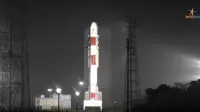From spinning wheel to spacecraft
22 Oct 2003
ISRO welcomed the 2003 Diwali season by firing its Rs 80-crore rocket from the Satish Dhawan Space Centre, Sriharikota. Emitting a deep and strong growl that vibrated throughout the launch centre, 49 metres tall and weighing 294 tonnes, the PSLV-C5 at 10.22 am roared upwards, piercing the dark rain clouds.
For those who witnessed the fifth commercial flight (eighth PSLV including three developmental flights) escape the gravitational pull with thick orange flame at its tail, it was something to cherish for long. Unlike the earlier launches, the vehicle was not visible to the naked eye during its ascent, thanks to the overcast sky.
The smooth launch had its anxious moments. It was a rainy morning and doubts persisted about ISRO going ahead with the launch. "With the weatherman predicting the onset of monsoon we were driven virtually to a corner," says G Madhavan Nair, chairman, ISRO, and secretary, Department of Space, and chairman, Space Commission.
As a result ISRO had to go ahead with its earlier plans, of course after analysing the pros and cons. Unlike the other ISRO launches, this one was slated for the morning to utilise the payload — Resourcesat-1 (Indian Remote Sensing Satellite IRS-P6) — effectively during its five-year life span.
 "But it was not a risky launch," says Nair. Nevertheless, he did feel a bit jittery. Nair, who has been part and parcel of ISRO's all the earlier 17 launches (starting from 1979 onwards), the PSLV-C5 launch is the first one from Sriharikota after he assumed the chairmanship last month.
"But it was not a risky launch," says Nair. Nevertheless, he did feel a bit jittery. Nair, who has been part and parcel of ISRO's all the earlier 17 launches (starting from 1979 onwards), the PSLV-C5 launch is the first one from Sriharikota after he assumed the chairmanship last month.
For space scientists it was not the takeoff that was the cause of concern — unlike Sivakasi rockets this one will not fuse out. But there was concern about the precise deployment of the satellite on account of the atmospheric winds, which will be strong when the weather is inclement. Further, ISRO wanted the satellite to cross the equator at 10.30 am, and hence the morning launch.
Confident of their calculations the scientists decided to go ahead and it ultimately turned out to be a textbook launch. "We can also say that one more page is being added to the textbook," says Nair.
Eighteen minutes after the lift-off, with all the four stages of the rocket burning well, the inertial navigation system kept at the fourth stage precisely guided the PSLV-C5 till it spit the 1,360 kg Resourcesat-1 (cost: Rs 150 crore) into an 821km high polar SSO with an inclination of 98.76 degree with respect to the equator.
Soon after that, the solar array generating 1,250 W was deployed. Further operations like three-axis stabilisation and camera release are being carried out. The satellite's health is monitored from the Spacecraft Control Centre at Bangalore with the help of ISTRAC network of stations in Bangalore, Lucknow, Mauritius, Bearslake, Russia and Biak in Indonesia.
The final switching on of the sophisticated cameras will take another week after undertaking activities like orbit trimming and checking out the various subsystems.
The satellite carries:
- A high-resolution linear imaging self-scanner (LISS-4) operating in three spectral bands in the visible and near infrared region (VNIR) with 5.8-metre spatial resolution and steerable up to 26 degree across track in order to obtain stereoscopic imagery and achieve a five-day revisit capability;
- A medium resolution LISS-3 operating in three spectral bands in VNIR and one in short-wave infrared (SWIR) band with 23.5-metre spatial resolution and;
- An advanced wide-field sensor (AWiFS) operating in three spectral bands in VNIR and one band in SWIR with 56-metre spatial resolution.
- Also present is a solid state recorder with a capacity of 120 giga bits to store the images taken by the cameras, which could be read out later to the ground stations.
Of the 12 remote sensing satellites sent up by ISRO till date, Resourcesat-1 is the most sophisticated as well as the heaviest. The satellite will continue the remote sensing data services provided by IRS-1C and IRS-1D that have outlived their design life, and also enhance the data quality.
Improved version
Compared to the previous edition, the latest PSLV is slightly different (). Says George Koshy, associate project director, PSLV, and the vehicle director for PSLV-C5: "The second stage has a high-pressure engine to give more power. The metallic third stage adapter is replaced by the one built with carbon composites." This time the engineers have optimised many structures in the launch vehicle.
 As per earlier plans, Resourcesat was to have the 40kg Hamsat as co-passenger. But some performance deviations were noted during the thermo-vacuum test. As the corrections could not be made within the time limit, Hamsat has to be left behind this time and will be accommodated on one of the subsequent flights of PSLV.
As per earlier plans, Resourcesat was to have the 40kg Hamsat as co-passenger. But some performance deviations were noted during the thermo-vacuum test. As the corrections could not be made within the time limit, Hamsat has to be left behind this time and will be accommodated on one of the subsequent flights of PSLV.
Of late, PSLV has been carrying multiple satellites. In 2001 PSLV-C3, while launching TES (a remote-sensing satellite) also gave list to two other spacecrafts — Bird of Germany and Proba of Belgium — fetching around $1 million from each of them towards carriage fee. In May 1999, the PSLV had put IRS-P4 along with German DLR and Korean KITSAT-3 into the orbit.
Does that mean PSLV-C5 is under-utilised? Not really, say ISRO officials. In terms of weight PSLV-C3 carried 1,294 kg (TES 1,108kg, Proba 94 kg and Bird 92 kg), whereas Resourcesat-1 weighs 1,360 kg. The absence of Hamsat that weighs just 40 kg hardly makes a difference.
Looking forward Koshy says PSLV-C9 will carry a payload of 1,800 kg. "We are looking at reducing the weight of the upper stage. Weight at the lower stage cannot be reduced as it contains mainly fuel to give the needed upward thrust."
ISRO has launched four satellites this year (G-Sat by Geosynchronous Satellite Launch Vehicle D2, Insat-3A and 3E by Ariane). According to the US-based Futron Corporation, globally 57 satellites were launched till September 2003. India commands 5-per cent share in the global satellite launches.
According to Nair, the second launch pad (outlay Rs 400 crore) will be ready next year so that bigger launch vehicles like the geosynchronous launch vehicle (GSLV) could be launched. The launch of two GSLV's was possible after modifying the present launch pad.
Though ISRO launches three vehicles in a year now, the second pad will enable the organisation increase the launch frequency. "The existing pad will not become redundant. It will be used for sending up PSLV. Further we can produce two vehicles simultaneously," he adds.
Zucconi, the head of Carlo Gavazzi Space that has launched 10 satellites, has not missed out ISRO's achievements and plans as he is zeroing on the carrier for the 500kg Agile. "Our budget for the proposed launch is around $9 million." For ISRO, Agile will be the first real heavy third-party payload. As the negotiations are under process, ISRO officials declined to comment on the matter.
Seeking 50% market share
Resourcesat-1, in the meantime, is expected to increase the export revenues from selling remote-sensing data by Rs 10 crore to Rs 30 crore per year. According to Nair, the nominal value of data used by various Indian organisations will be around Rs 80 crore.
 The global market for remote-sensing images is around $120 million. ISRO is one of the major players in this field and earns around Rs 20 crore. "Our target is to increase our global market share to 50 per cent," says K R Sridhara Murthi, executive director, Antrix Corporation, the commercial arm of ISRO. The company has a tie up with the US-based Space Imaging Corporation for marketing the remote-sensing data worldwide.
The global market for remote-sensing images is around $120 million. ISRO is one of the major players in this field and earns around Rs 20 crore. "Our target is to increase our global market share to 50 per cent," says K R Sridhara Murthi, executive director, Antrix Corporation, the commercial arm of ISRO. The company has a tie up with the US-based Space Imaging Corporation for marketing the remote-sensing data worldwide.
Leasing of transponders in the Insat satellite series is yet another revenue source for ISRO. The organisation, leasing out 108 transponders out of 120 it owns, earns Rs 150 crore per year. According to ISRO officials, the latest Insat 3E carrying 24 normal C-band and 12 extended C-band transponders will be switched on during the first week of November 2003. Insat 3E transponders will replace some of the older ones in the Insat series. Except for six extended C-band transponders all others have been booked, say ISRO officials.
Future programmes| Abbreviations HTPB: Hydroxyl terminated poly butadiene N2O2: Nitrogen tetroxide MMH: Mono-methyl hydrazine MON: Mixed oxides of nitrogen |
During 2004-05, Cartosat-1 (IRS-P5) will be sent up by ISRO. The satellite is expected to provide a 2.5-metre spatial resolution, stereo imagery using two panchromatic cameras. It will thus provide terrain height information and will considerably improve the contour information for developmental applications of relevance to urban management and other applications.
The year 2006 will see Radar Imaging Satellite (Risat) carrying a C-band Synthetic Aperture Radar (SAR) with a spatial resolution of 3-to-50 m while a swath of 10 km to 240 km is under development. With an all-weather remote sensing capability, Risat will enhance remote-sensing applications in the areas of agriculture and disaster management.
























